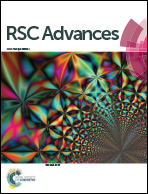Enhanced efficacy of chemotherapeutic drugs against colorectal cancer using ligand-decorated self-breakable agents†
Abstract
Several types of nano-sized anti-cancer agents that could increase the accumulation of drugs in tumor sites have been created and developed to enhance the efficacy of chemotherapeutic drugs in colon cancer treatment. In addition, to achieve the optimal cancer chemotherapeutic efficacy, nano-sized agents with specific functions were designed to efficiently kill cancer cells. The ideal nano-sized agent must be able to successfully release the drug and result in an increased cellular uptake of the chemotherapeutic drug. Our research team focused on two important functions, i.e. drug release and targeting functions, thus targeting functional micelles that were designed to possess disulfide bonds and entrapped much of the chemotherapeutic drug, 7-ethyl-10-hydroxy-camptothecin (SN38), which was created as a powerful candidate for an ideal anti-cancer drug for colon cancer treatment. In particular, self-breakable SN38-loaded micelles (SN/38 micelles), non-breakable SN38-loaded micelles (NB/38 micelles) and folate-decorated self-breakable SN38-loaded micelles (FSB/38 micelles) were prepared and tested on the designed agents. The results showed that the folate-decorated functional micelles with disulfide bonds could be an effective chemotherapeutic agent for colon cancer treatment.


 Please wait while we load your content...
Please wait while we load your content...